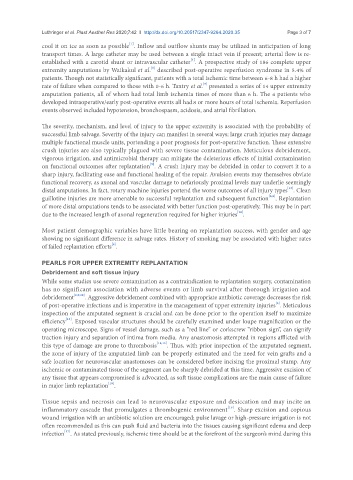Page 479 - Read Online
P. 479
Luthringer et al. Plast Aesthet Res 2020;7:42 I http://dx.doi.org/10.20517/2347-9264.2020.35 Page 3 of 7
[1]
cool it on ice as soon as possible . Inflow and outflow shunts may be utilized in anticipation of long
transport times. A large catheter may be used between a single intact vein if present; arterial flow is re-
[1]
established with a carotid shunt or intravascular catheter . A prospective study of 186 complete upper
[8]
extremity amputations by Waikakul et al. described post-operative reperfusion syndrome in 5.4% of
patients. Though not statistically significant, patients with a total ischemic time between 6-8 h had a higher
[9]
rate of failure when compared to those with 0-6 h. Tantry et al. presented a series of 14 upper extremity
amputation patients, all of whom had total limb ischemia times of more than 6 h. The 4 patients who
developed intraoperative/early post-operative events all had 8 or more hours of total ischemia. Reperfusion
events observed included hypotension, bronchospasm, acidosis, and atrial fibrillation.
The severity, mechanism, and level of injury to the upper extremity is associated with the probability of
successful limb salvage. Severity of the injury can manifest in several ways; large crush injuries may damage
multiple functional muscle units, portending a poor prognosis for post-operative function. These extensive
crush injuries are also typically plagued with severe tissue contamination. Meticulous debridement,
vigorous irrigation, and antimicrobial therapy can mitigate the deleterious effects of initial contamination
[9]
on functional outcomes after replantation . A crush injury may be debrided in order to convert it to a
sharp injury, facilitating ease and functional healing of the repair. Avulsion events may themselves obviate
functional recovery, as axonal and vascular damage to nefariously proximal levels may underlie seemingly
[12]
distal amputations. In fact, rotary machine injuries portend the worse outcomes of all injury types . Clean
[6,8]
guillotine injuries are more amenable to successful replantation and subsequent function . Replantation
of more distal amputations tends to be associated with better function post-operatively. This may be in part
[10]
due to the increased length of axonal regeneration required for higher injuries .
Most patient demographic variables have little bearing on replantation success, with gender and age
showing no significant difference in salvage rates. History of smoking may be associated with higher rates
of failed replantation efforts .
[8]
PEARLS FOR UPPER EXTREMITY REPLANTATION
Debridement and soft tissue injury
While some studies use severe contamination as a contraindication to replantation surgery, contamination
has no significant association with adverse events or limb survival after thorough irrigation and
debridement [6,9,12] . Aggressive debridement combined with appropriate antibiotic coverage decreases the risk
[6]
of post-operative infections and is imperative in the management of upper extremity injuries . Meticulous
inspection of the amputated segment is crucial and can be done prior to the operation itself to maximize
efficiency . Exposed vascular structures should be carefully examined under loupe magnification or the
[13]
operating microscope. Signs of vessel damage, such as a “red line” or corkscrew “ribbon sign”, can signify
traction injury and separation of intima from media. Any anastomosis attempted in regions afflicted with
this type of damage are prone to thrombosis [14,15] . Thus, with prior inspection of the amputated segment,
the zone of injury of the amputated limb can be properly estimated and the need for vein grafts and a
safe location for neurovascular anastomoses can be considered before incising the proximal stump. Any
ischemic or contaminated tissue of the segment can be sharply debrided at this time. Aggressive excision of
any tissue that appears compromised is advocated, as soft tissue complications are the main cause of failure
in major limb replantation .
[16]
Tissue sepsis and necrosis can lead to neurovascular exposure and desiccation and may incite an
[16]
inflammatory cascade that promulgates a thrombogenic environment . Sharp excision and copious
wound irrigation with an antibiotic solution are encouraged; pulse lavage or high-pressure irrigation is not
often recommended as this can push fluid and bacteria into the tissues causing significant edema and deep
[17]
infection . As stated previously, ischemic time should be at the forefront of the surgeon’s mind during this

